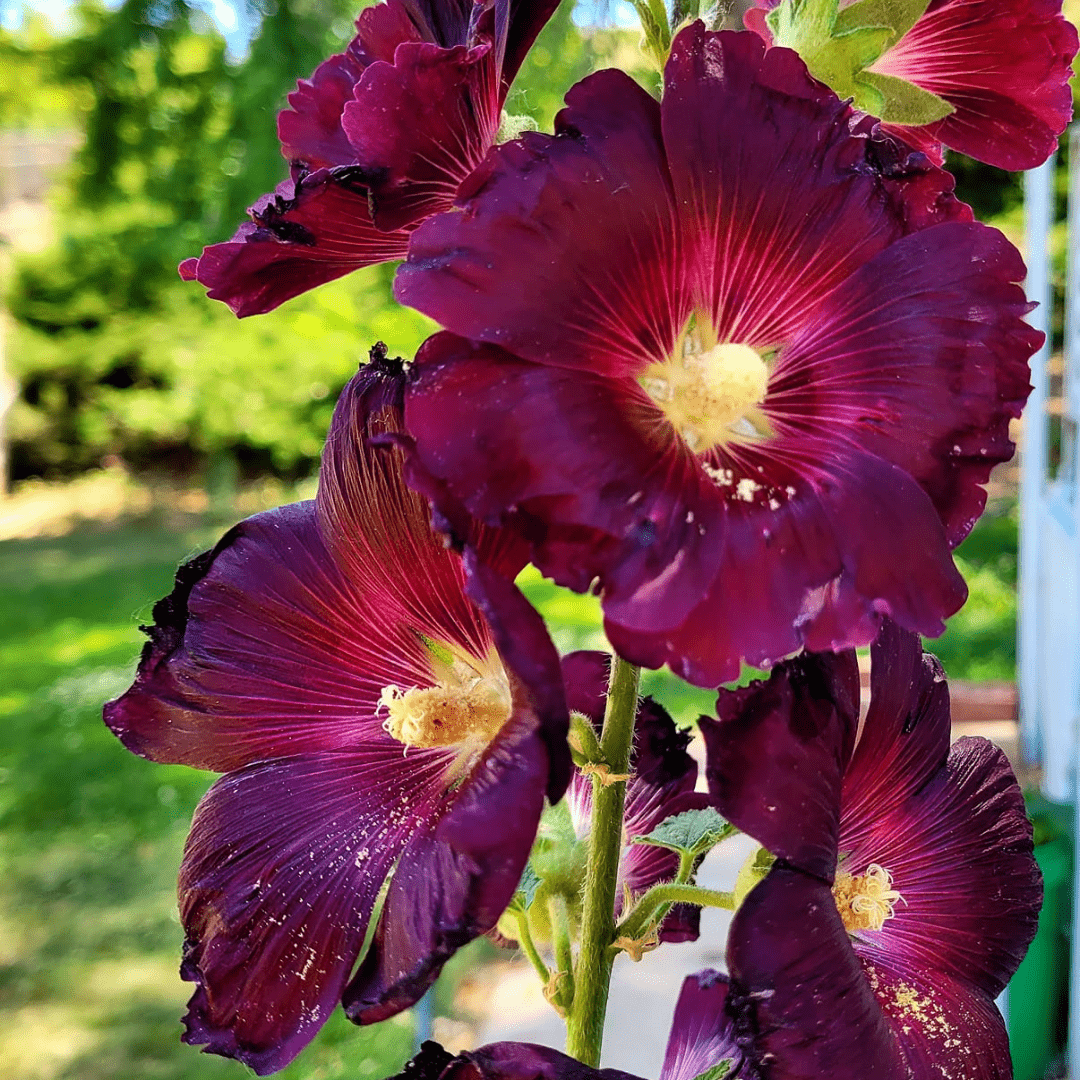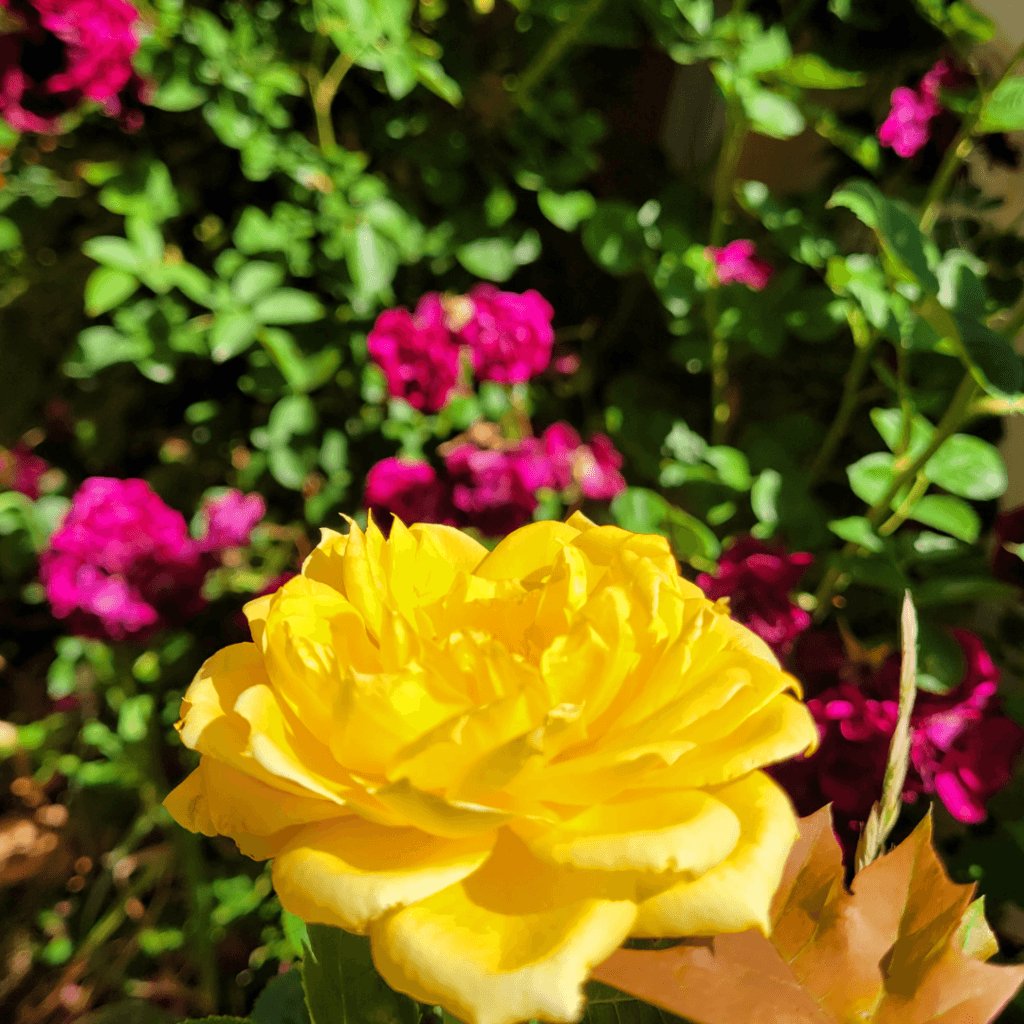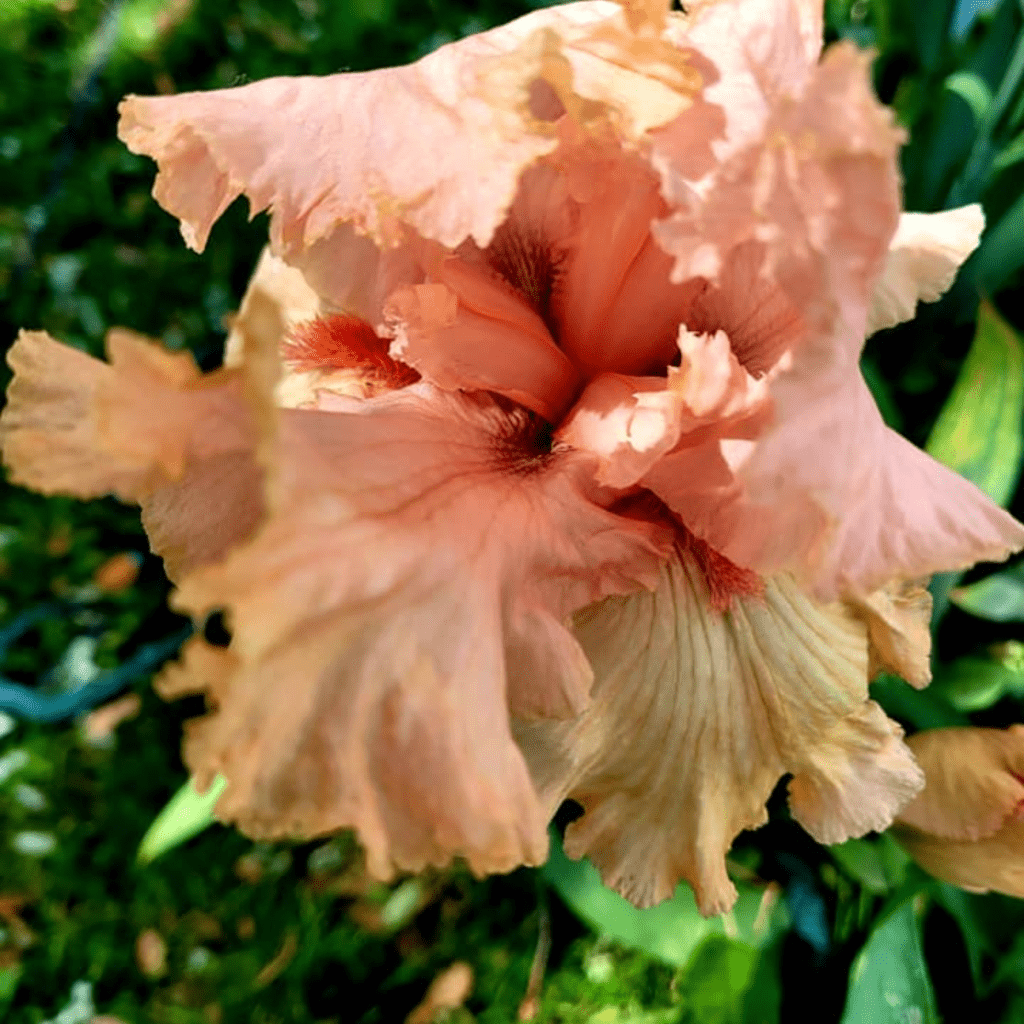Hollyhocks bring vertical beauty and old-fashioned charm to any garden. On our brick homestead, I’ve learned how to grow and care for hollyhocks in a simple, practical way. With the right planting, support, and care, these cottage garden favorites thrive year after year.
Hollyhocks are one of those flowers that instantly evoke a sense of nostalgia. Their tall, colorful spikes feel right at home along fences, brick walls, and garden paths, giving a cottage garden its classic charm. On our brick homestead, I’ve learned that growing hollyhocks doesn’t have to be complicated—they’re forgiving, resilient, and full of personality.
Planting hollyhocks is just the beginning. With a little support, occasional pruning, and attention to soil and sun, these flowers can thrive for years, reseeding themselves to create a natural, layered look. They reward patience with stunning blooms that make a garden feel timeless.
In this guide, I’ll share everything I’ve learned about how to grow and care for hollyhocks on a brick homestead—from planting and spacing to staking and maintenance—so you can enjoy these charming, old-fashioned flowers season after season.
Hollyhocks vs Marshmallows
While the marshmallow plant offers softer roots than hollyhocks, I choose to grow hollyhocks over marshmallows simply because hollyhocks’ blooms are bigger and brighter, at least in my humble opinion!
I have been growing hollyhocks for six years. The hollyhock plants in my cottage garden are a deep maroon color to pale pink. I plan to start adding a variety of colors of hollyhocks to my cottage garden. They are biannals, meaning they have a two-year lifespan. In the first year, they produce their bushy leaves and establish their root systems, and then they bloom in their second year. They produce a ton of seeds and self-seed their beds, making them seem as if they are perennials.
This is a pinnable post. Tap or hover over any image in this post to pin to your Pinterest Boards.
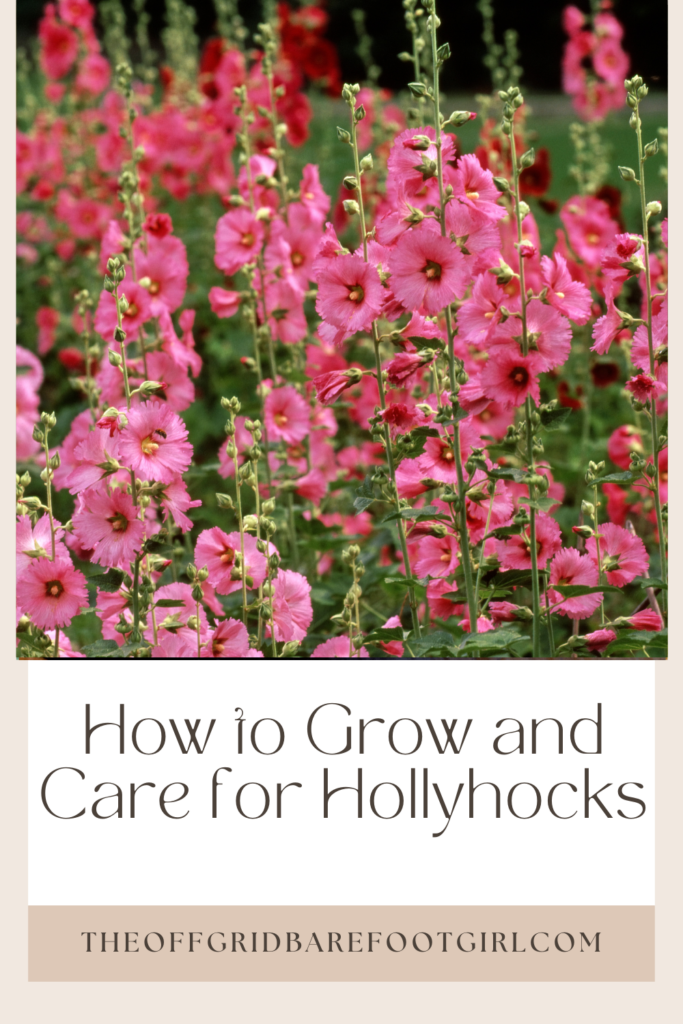
How to Grow Hollyhocks
I’ve always loved growing hollyhocks on our brick homestead—they bring a sense of nostalgia and simple joy that few other flowers can match. There’s something magical about seeing their tall, colorful spikes rise above the garden, softening brick walls and walkways while creating a gentle, old-fashioned charm. They’re forgiving, resilient, and surprisingly low-maintenance, yet their blooms make a big impact, turning even a quiet corner into a statement of color and life.
Every year, I look forward to their gradual opening from the bottom of the stalk to the top, a slow reveal that keeps the garden lively for weeks. Watching bees and butterflies visit the blooms feels like a reward for the patience and care I’ve given them. Hollyhocks aren’t just flowers—they’re part of the rhythm and history of the garden, a living connection to old-fashioned cottage gardening that I treasure deeply.
I love that they self-seed year after year, quietly returning to bring joy without demanding much from me. They’ve become more than just plants—they’re companions in my garden, reminders to embrace beauty, patience, and practicality in the simple, barefoot way we live on our homestead.
Choosing the Right Hollyhocks for Your Garden
Picking Varieties That Thrive
Hollyhocks come in a wide range of colors, sizes, and forms, so choosing the right variety is key. I prefer old-fashioned, hardy types that are naturally resilient and can handle changing weather in my area. These varieties are forgiving if left alone for a season and tend to reseed reliably.
When selecting hollyhocks, consider bloom time and height. Taller varieties create dramatic vertical accents near walls or fences, while shorter ones work well along pathways or in front of taller perennials. Choosing a mix of colors adds depth and visual interest throughout the growing season.
It’s also important to think about disease resistance. Some modern hybrids can be more susceptible to rust and mildew. I stick with hardy, traditional varieties whenever possible—they’re low-maintenance and suited to the natural rhythms of a cottage garden.
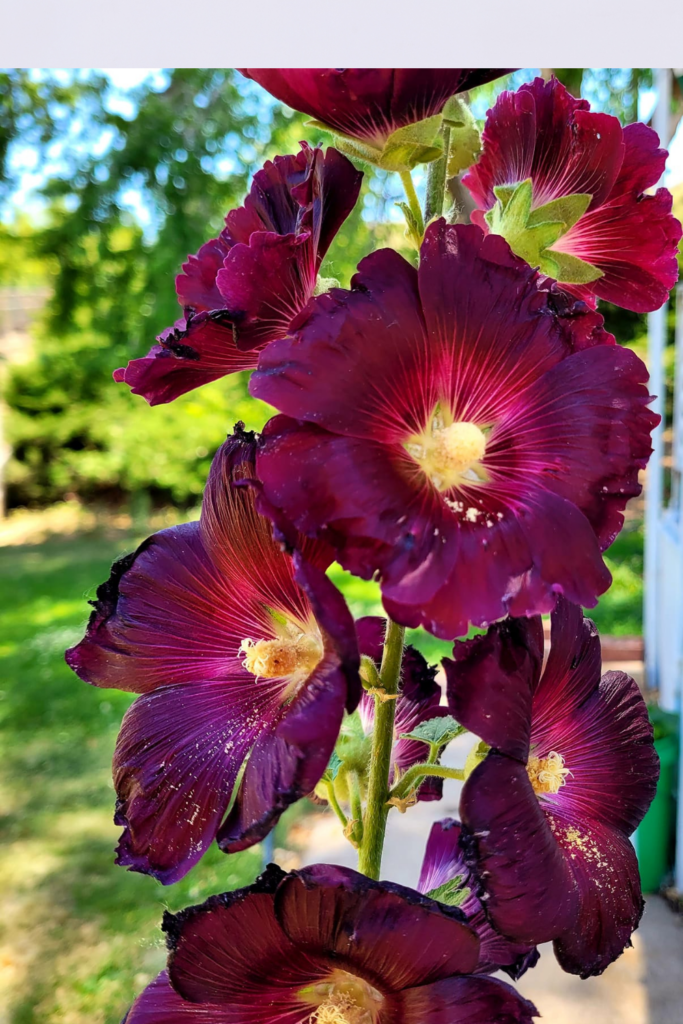
When Hollyhocks Bloom
Hollyhocks are one of those flowers that announce summer’s arrival in a cottage garden. Typically, they begin to bloom in mid to late summer, often from June through August, depending on your climate and when they were planted. On our brick homestead, I’ve noticed that planting in early spring or starting seeds indoors can influence just how early the first blooms appear.
The blooms open gradually from the bottom of the spike to the top, creating a cascading effect that keeps the garden colorful for weeks. Each flower spike can last for several weeks, and with multiple plants in succession, you can enjoy continuous color through the growing season. This layered blooming pattern is one of the reasons hollyhocks are so beloved in cottage gardens—they add drama without overwhelming the space all at once.
Even though hollyhocks are technically biennials, their ability to self-seed often means that new plants will bloom in the second year, creating a steady rhythm of flowers in your garden. By understanding their bloom cycle and planning for successive planting, you can ensure that your garden remains lively and full of old-fashioned charm throughout summer.
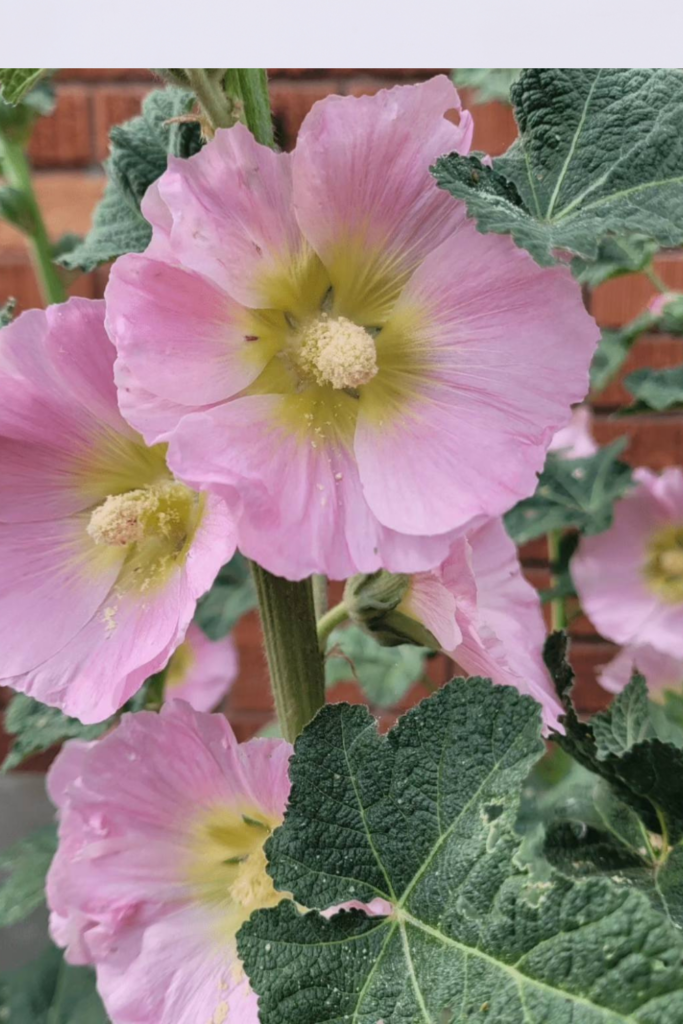
Site Selection and Sunlight Needs
Hollyhocks love full sun. I plant mine where they receive at least six hours of direct sunlight each day, which encourages strong, healthy growth and abundant blooms. On a brick homestead, sunny walls or open garden beds work beautifully.
Soil drainage is equally important. Hollyhocks prefer soil that drains well but still retains moisture. I often amend my garden beds with compost to improve soil structure and keep the roots happy. Avoid low spots where water tends to collect like near downspouts, as this can lead to root rot.
Spacing is key to airflow, which helps prevent mildew and rust. I plant hollyhocks at least 18 to 24 inches apart to give each plant room to grow and ensure air can move freely through the leaves, which keeps them healthier throughout the season.
Planting Hollyhocks
Starting From Seeds
Many hollyhocks grow best from seed. I usually start seeds indoors a few weeks before the last frost, but they also germinate well when sown directly in the garden. Lightly cover seeds with soil, water gently, and keep them moist until seedlings emerge.
Hollyhocks are biennials or short-lived perennials, so the first year often produces leaves rather than flowers. Don’t be discouraged—year two brings tall spikes of color that reward patience and planning. Planting in succession ensures you’ll have blooms every season.
Once seedlings are strong enough to handle outdoor conditions, I harden them off gradually, letting them adjust to sunlight and temperature changes before planting them permanently in the garden bed. This helps ensure they establish quickly and grow robustly.
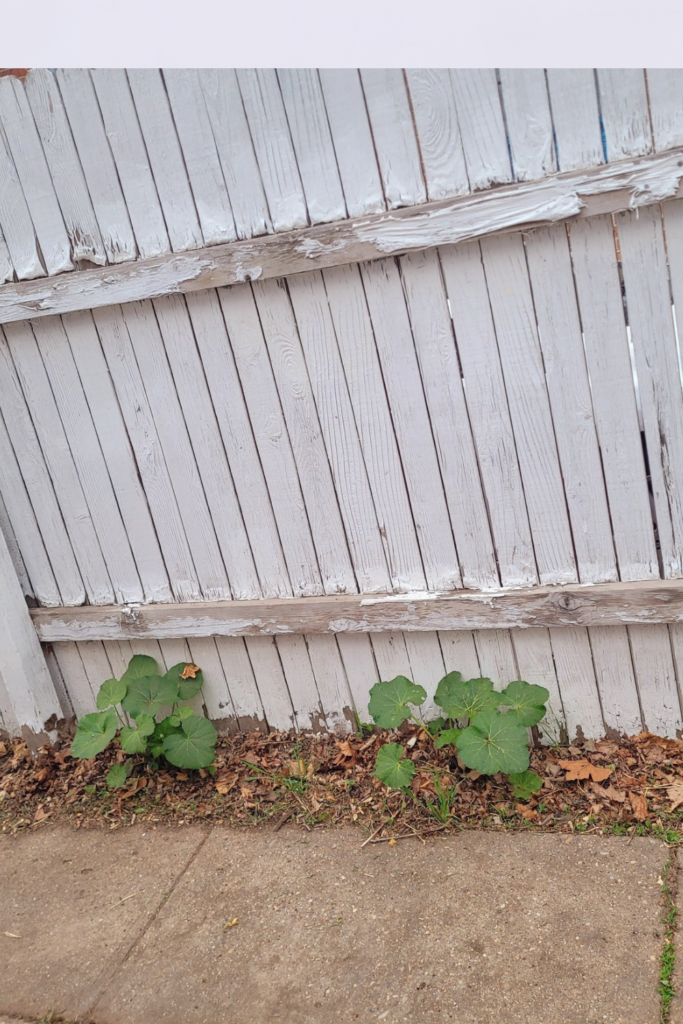
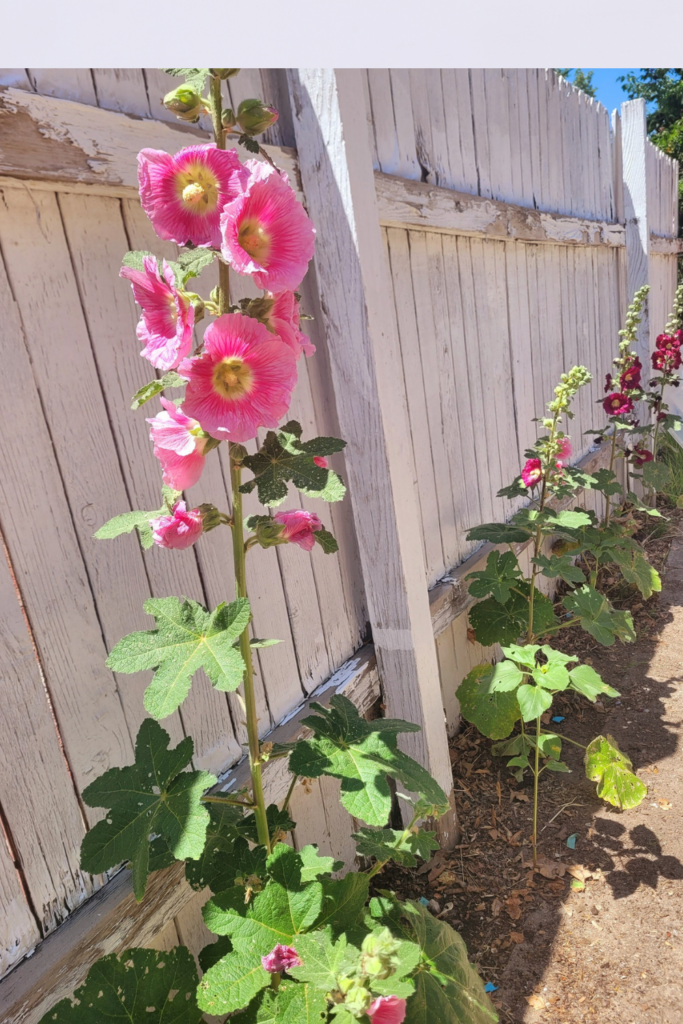
Collecting and Saving Hollyhock Seeds
Hollyhocks are generous plants, and collecting their seeds is an easy way to keep your garden blooming year after year. I like to let the flowers fade naturally, allowing the seed pods to form and dry on the plant. The pods are ready to harvest when they turn brown and start to crack open, usually in late summer or early fall.
To collect the seeds, gently pinch the pods and shake the seeds into a glass jar, paper bag or envelope. Once collected, I label the jar with the variety and year so I know exactly what I’m planting next season. Hollyhocks produce plenty of seeds, so even a few plants can provide enough for your entire garden.
Saving seeds isn’t just practical—it’s part of the self-sufficient, old-fashioned gardening I love. By harvesting and storing hollyhock seeds, you can continue a cycle of blooms without buying new plants each year. Over time, your garden develops a history of plants uniquely suited to your soil and climate, creating a true living legacy around your brick homestead.
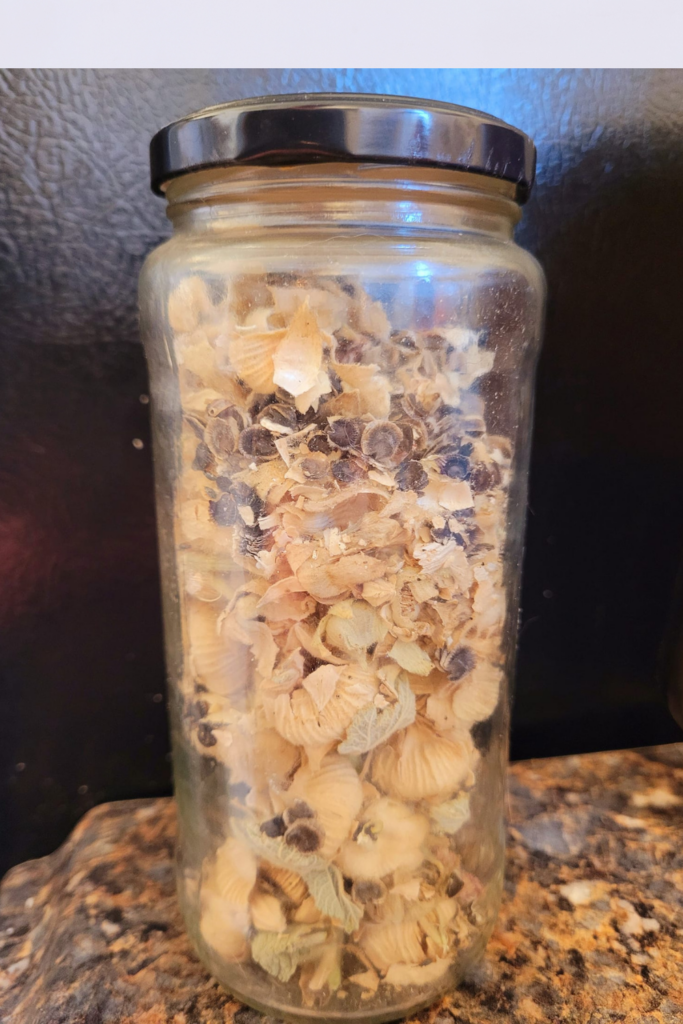
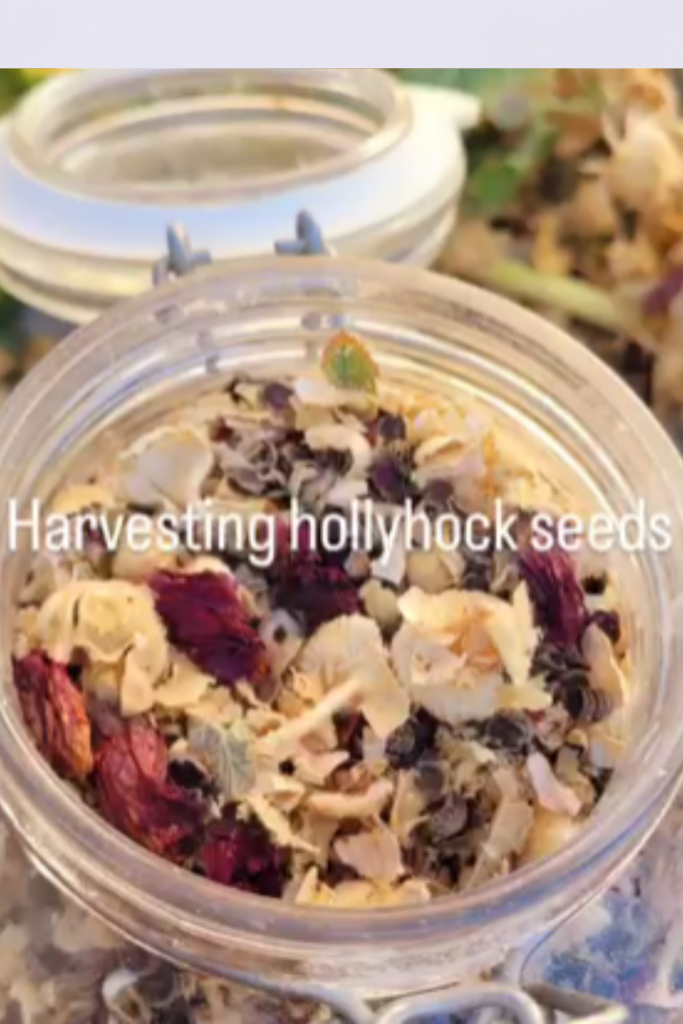
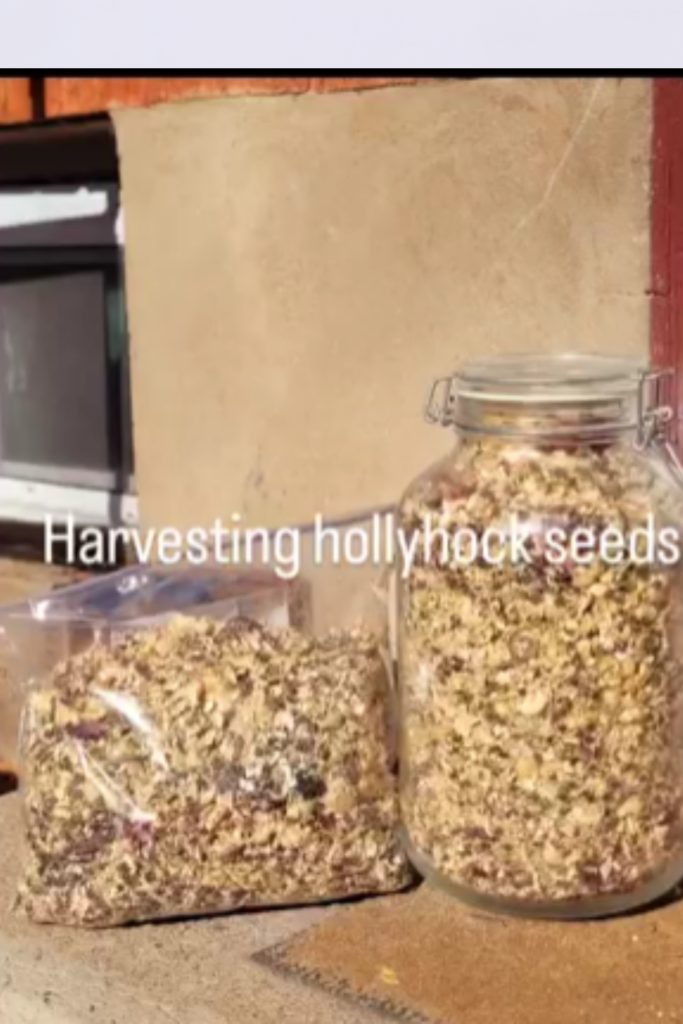
Transplanting and Soil Preparation
Before planting, I prepare the soil by loosening it and mixing in compost or well-rotted organic matter. Hollyhocks prefer slightly rich soil to support tall growth and large blooms. A little care in soil preparation goes a long way toward healthy, long-lasting plants.
When transplanting, I dig holes slightly larger than the root ball and place the seedlings gently, filling in with soil and watering immediately. Keeping the soil consistently moist for the first few weeks helps roots take hold.
Mulching around the base of the plant keeps moisture in, regulates temperature, and reduces weed growth. I like to use natural mulches like straw or shredded leaves, which fit perfectly into the old-fashioned, practical style of a cottage garden.
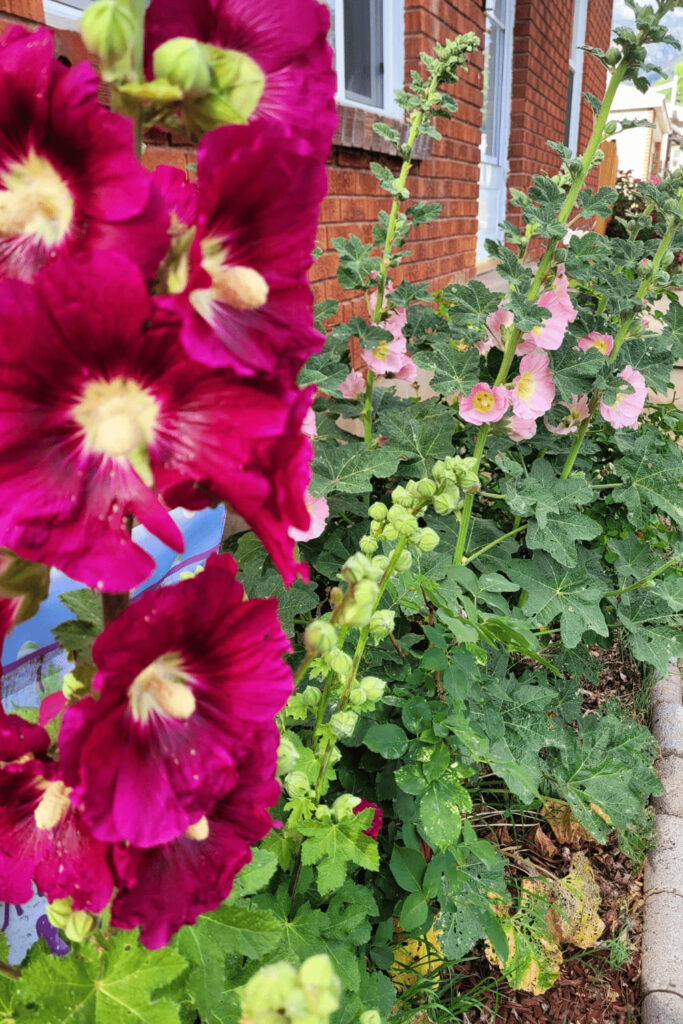
Caring for Hollyhocks
Watering and Feeding
Hollyhocks need consistent watering, especially during dry spells. I water deeply at the base, avoiding wetting the foliage, which helps prevent disease. A simple watering routine keeps plants strong and encourages more blooms throughout the season.
Feeding is straightforward. I use an all-purpose organic fertilizer or compost tea once or twice during the growing season to support vigorous growth. Over-fertilizing can lead to floppy stems, so I keep it balanced and natural.
Healthy hollyhocks are happy hollyhocks. With the right watering and feeding, they will produce vibrant flowers that continue to enrich the garden long into summer.
Staking, Pruning, and Disease Prevention
Tall hollyhocks often need support. I stake mine early in the season with bamboo or wooden stakes to prevent stems from bending or breaking in wind. Secure plants gently so they can grow upright without damage.
Pruning spent flowers encourages new blooms and keeps plants tidy. I remove old leaves and trim faded flowers carefully, which also helps reduce the risk of rust and mildew.
Regular monitoring is key to disease prevention. Hollyhocks can be prone to rust, so I remove affected leaves promptly and space plants for airflow. Good cultural practices often prevent problems before they start.
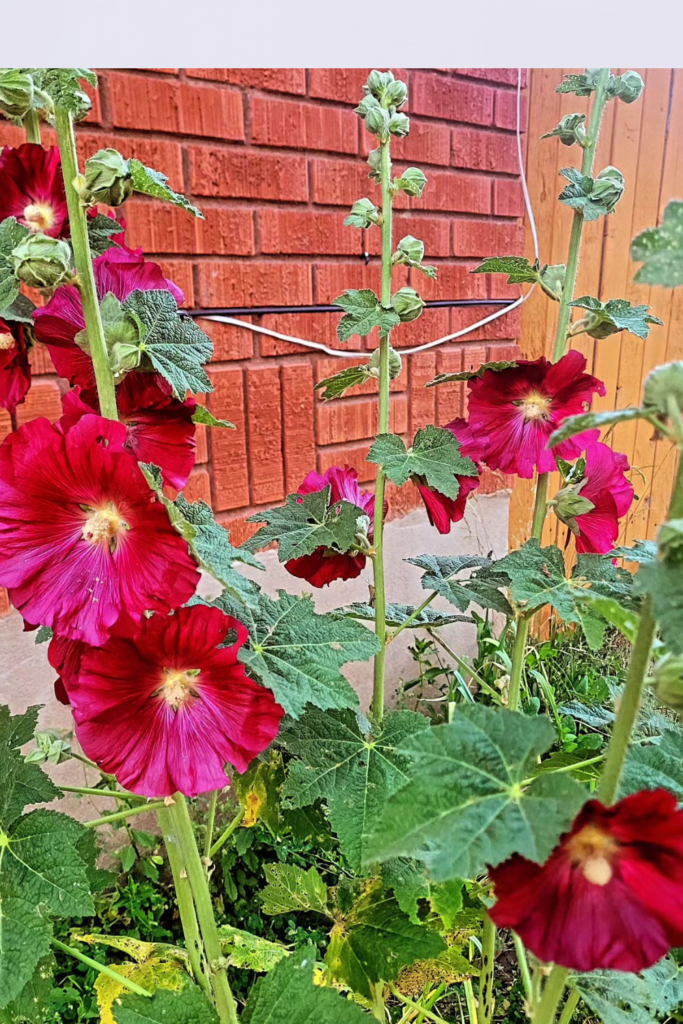
Using Hollyhocks in Your Cottage Garden
Hollyhocks aren’t just tall and beautiful—they create a sense of structure and nostalgia in the garden. I plant them along fences, walkways, or against brick walls to create height, interest, and a backdrop for other perennials and herbs.
These flowers fit naturally into a self-sufficient cottage garden. They attract pollinators, reseed themselves, and add seasonal drama without requiring constant maintenance. Pairing them with roses, irises, and tulips creates a layered, lived-in look.
Hollyhocks also have practical uses. Historically, parts of the plant were used in remedies, crafts, or decoration. Even today, growing flowers with multiple purposes fits perfectly with a brick homestead’s practical, old-fashioned approach.
Conclusion
Hollyhocks are a cornerstone of any classic cottage garden. Tall, forgiving, and full of charm, they bring color, height, and old-fashioned beauty to a homestead garden. With the right care—sunlight, soil, water, staking, and pruning—they thrive for years, reseeding to provide continual blooms.
On a brick homestead, hollyhocks feel at home, softening hard edges and blending seamlessly with roses, perennials, and other traditional flowers. By growing them the old-fashioned way, you can enjoy a practical, self-sufficient, and timeless garden that evolves naturally each season.
For more inspiration to grow your own cottage garden, read my comprehensive guide: Cottage Gardening on a Brick Homestead: How I Grow a Beautiful, Practical Garden the Old-Fashioned Way.
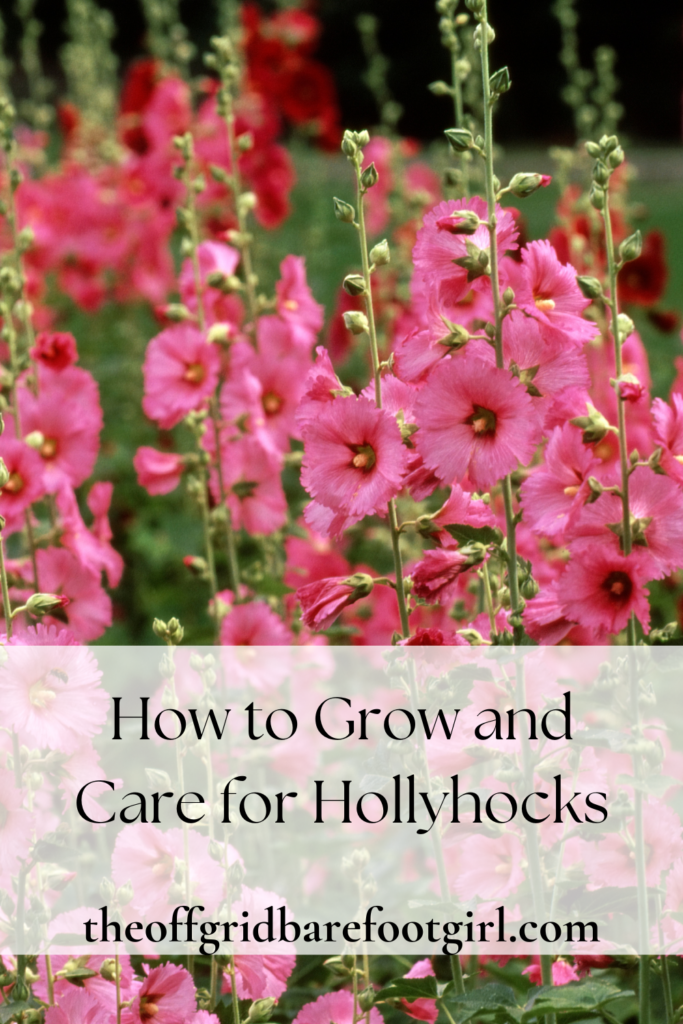
Frequently Asked Questions
1. When should I plant hollyhocks?
Hollyhocks can be started from seed indoors a few weeks before the last frost or sown directly in the garden after frost danger has passed. They often bloom in their second year.
2. How tall do hollyhocks grow?
Most hollyhocks reach between 5 and 8 feet tall, making them ideal for creating vertical interest along walls or fences in a cottage garden.
3. How do I prevent hollyhock rust?
Ensure proper spacing for airflow, remove affected leaves promptly, water at the base of plants, and consider staking tall varieties to reduce stress on stems.
4. Can hollyhocks self-seed?
Yes! Hollyhocks reseed naturally, often returning year after year with minimal intervention, making them a reliable and low-maintenance addition to a cottage garden.
Summary
I hope I have inspired you to grow flowers in your garden with these tips and products.
If you were encouraged by this post, I invite you to check out my FREE Printables Page for fun free printables, planners, and charts.
ENTER MY FREE Printables Page HERE
Here are some more of my gardening inspiration posts to check out!
How to Grow and Care for Tiger Lilies
The Ultimate Guide to Growing Your Dream Flower Garden!
The Best Perennial Flowers for a Low-Maintenance Garden!
How to Design a Cottage Garden: Growing a Beautiful Mess
Roses: How to Grow and Care for Roses
Hollyhocks: How to Grow and Care for Hollyhocks
Tulips: How to Grow and Care for Tulips
PeeGee Hydrangea Trees: How to Grow and Care for a PeeGee Hydrangea Tree
Bearded Irises: How to Grow and Care for Bearded Irises
Blessings,
The Off Grid Barefoot Girl

